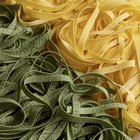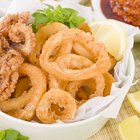
To keep rolled dumplings fluffy, you first have to make fluffy rolled dumplings. Because dumplings tend to get "heavy" if they sit in the broth too long, start off with a light, barely mixed dough and cook it as gently as possible for them to stay fluffy. Store and reheat the dumplings separately to keep them light after you cook them.
Keep It Simple
When it comes to keeping rolled dumplings light, you have to start light, and that means using as few ingredients as possible. At their worst, you'll find rolled dumpling recipes calling for two types of fat, powdered bullion and a couple leavening agents, in addition to flour and milk. Nothing about rolled dumplings -- or any dumpling, for that matter -- should be complicated. Classic rolled dumplings require flour, dairy and fat in an eight-to-four-to-one ratio, along with 2 teaspoons of a leavening agent for each cup of flour. For example, a basic dumpling recipe comprises 2 cups of flour, 1 cup of dairy and 1/4 cup of butter. Use all-purpose flour, whole milk for the dairy, whole butter for the fat and baking powder for leavening.
Don't Overwork the Dough
Rolled dumplings are cooked dough, no different in principle than bread, biscuits or brioche. Just like with baked goods, you can't get a fluffy dough if you overmix. Gluten strands toughen the more you knead, so manipulate the dumpling dough as little as possible. Start by sifting the flour into the mixing bowl and adding the baking powder. Season the flour with a pinch of salt and whisk until combined with a balloon whisk. Add ice cold butter to the dry ingredients and cut it in with a pastry cutter. Add half the milk and mix the dough just enough for it to hold together. Add more milk as needed, a drizzle at a time. You usually have about 1/4 cup of milk leftover per cup if you add it sparingly and mix evenly.
Flour Lightly and Roll Softly
An over-floured work surface makes rolled dumplings stodgy and dense by incorporating more flour to their exterior, basically adding an unnecessary layer of starch to an otherwise lean and light dumpling. Instead of grabbing a healthy pinch of flour and scattering on the work surface, sift a light dusting of flour on it using the flour sifter. Turn the dough out onto the work surface and roll it to 1/8 inch thickness with a French rolling pin. You tend to exert less pressure when rolling and have more control over the dumplings' thickness because French pins are lighter than roller-type pins. Roll the dough by placing the pin in the center of the dough horizontally. Roll forward three or four times, turn the dough a quarter turn to the right, then roll softly forward again three or four times. Continue rolling softly then rotating until the dough measures 1/8 inch thick. Cut the dough into 1-inch squares with a pastry wheel.
Cook Gently
Nothing takes the fluffiness out of dumplings faster than plunging them into a boiling pot of liquid and stirring them vigorously. Cook the dumplings gently with the steam from the broth to keep them fluffy for as long as possible. Bring the broth to a steady simmer, or until it bubbles regularly but not violently. Carefully lift the dumplings with a spatula or your fingers and float them flat on top of the broth. After you float the dumplings -- some might sink, but that's OK -- cover the pot and cook them for five minutes. The dumpling tops will cook by steam and the bottoms will absorb the broth. Uncover the pot after five minutes and turn the heat down to a bare simmer. Cook for an additional 10 to 15 minutes without stirring. Serve immediately.
Store Carefully
Take the dumplings from the broth while still hot and store them separately if you have leftovers. Storing them out of the broth minimizes any heaviness or density they gained while swimming. To reheat the dumplings, bring the broth to a simmer and place a steamer basket on the pot. Place the dumplings in the steamer, cover and steam for 10 minutes. Add the dumplings to the bowls of broth when serving.
Related Articles

Will My Dumplings Get More Airy As They ...

How to Make Homemade Traditional Polish ...

Can You Substitute Margarine for ...

How to Cook Dumplings in the Crockpot

How to Make French Sauce With Roux of ...

Can You Make Dumplings With Cornstarch?

How to Cook Fresh Pasta Dough
What Can I Substitute for Cornstarch?

Does Cornstarch Make Fried Chicken ...
Easy Cinnamon Roll Recipe

How to Make Quick German Spaetzle

How to Cook Tamales With Raw Masa

Can I Make Chapati Dough in Advance?

Can You Cook Dumplings Out of Pizza ...

How to Marinate & Fry Squid

Can You Use Vegetable Oil Instead of ...

How to Separate Fat Without a Fat ...

Shortbread Cookie Recipe

How to Steam Flour Tortillas

How to Cook Pancetta
References
Writer Bio
A.J. Andrews' work has appeared in Food and Wine, Fricote and "BBC Good Food." He lives in Europe where he bakes with wild yeast, milks goats for cheese and prepares for the Court of Master Sommeliers level II exam. Andrews received formal training at Le Cordon Bleu.
Photo Credits
Polka Dot Images/Polka Dot/Getty Images